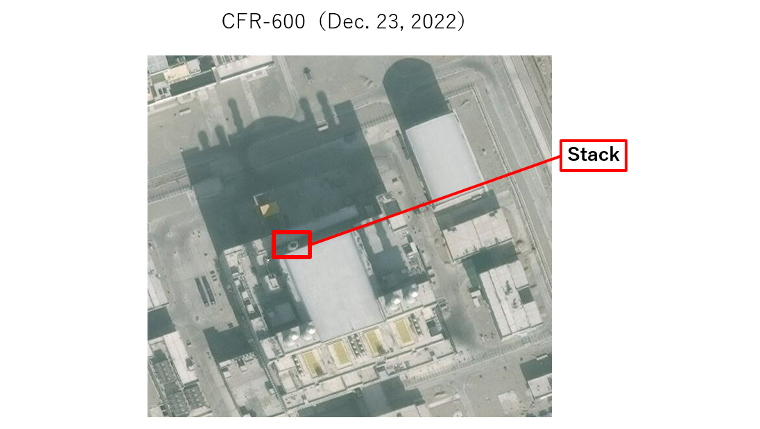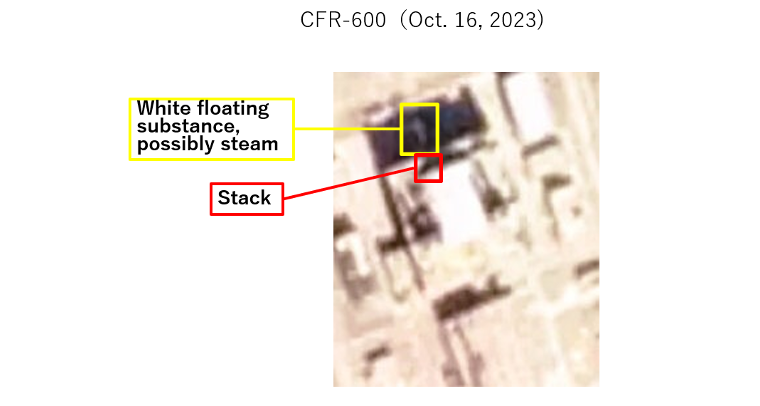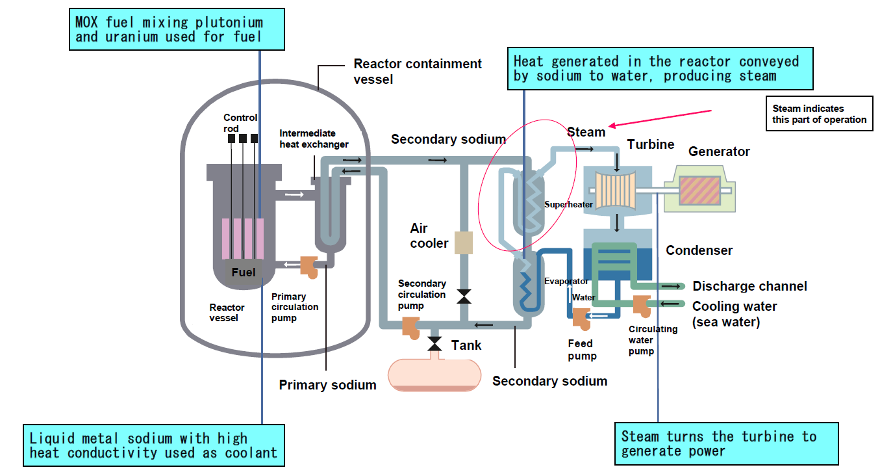Satellite Imagery Analysis 2023/11/30
China’s Fast Breeder Reactor Operating?
Possibility of Accelerating Nuclear Arms Race
Yuki Kobayashi (Research Fellow, Sasakawa Peace Foundation)
China is accelerating its nuclear armament to achieve military power balance with the U.S. The 2023 edition of the U.S. Defense Department’s annual report to Congress, Military and Security Developments Involving the People’s Republic of China, was released on Oct. 19. It warns that “China is increasing its number of nuclear warheads at a faster pace than previously estimated.”[1] It was previously predicted that, “Over the next decade, China’s nuclear warhead stockpile—currently estimated to be in the low-200s—is projected to at least double in size.” (according to the 2020 edition of this report.[2]) The 2023 report points out that the number of China’s nuclear warheads has already exceeded 500, reaching the estimate in the 2020 edition. Therefore, the report has revised its estimate upward to “over 1,000 operational warheads by 2030.” The New Strategic Arms Reduction Treaty (New START)signed between the two nuclear superpowers, the U.S. and Russia, sets the ceiling of the number of deployed warheads on both sides at 1,550. This means that the Pentagon report has determined that China will exceed this number in the early 2030s.
This U.S. prediction is based on its analysis that China is increasing its production of plutonium for civilian use (for power generation) and attempting to convert this secretly to military use. Specifically, this refers to China’s plans for fast breeder reactors (FBR), which produce more fuel than what they consume while generating power. It is possible to extract super-grade plutonium (ultrapure plutonium-239) ideal for use for nuclear weapons by reprocessing spent fuel from FBRs.
Sasakawa Peace Foundation’s China Observer, through its analysis of satellite images of the FBR under construction in Fujian Province in the coastal area facing Taiwan, has pointed out that this facility may start operation in 2023 (see Yuki Kobayashi, “China’s Plutonium Production and Nuclear Arms Expansion”). An analysis of the latest images acquired in October 2023 shows what appears to be steam coming out from the stack of the building housing the FBR. The emission of steam means that equipment necessary for operating the reactor is running, so it is highly possible that the FBR has already started operating. China is entering the mass production phase of plutonium indispensable for its nuclear arms expansion.
This article aims to analyze developments surrounding China’s FBRs based on satellite images and the experience of Japan’s FBR, Monju, prior to commencing operation.
According to a report of the International Atomic Energy Agency (IAEA), China began building a FBR named CFR-600 in Fujian in 2017, with a plan to start operations in 2023.[3] In an FBR, nuclear fuel in the reactor is covered with liquid sodium instead of water to accelerate nuclear fission reaction, thus generating a massive amount of steam by transmitting heat produced in the reactor to the steam generator, which is then conveyed to the turbine to generate electricity. The Chinese government and China National Nuclear Corporation (CNNC), the FBR’s operator, have not revealed any information on the CFR after submitting an initial report to the IAEA,[4] but satellite image analysis shows that the FBR is moving steadily toward starting operation.
The following satellite images of the FBR’s grounds (Satellite Image 1 and 2) were taken on Dec. 23, 2022, and Oct. 16, 2023, respectively. Compared to Image 1, Image 2 has definition issues, so they were analyzed very carefully.

Satellite Image 1
(Source)© Maxar Technologies, Inc.

Satellite Image 2
(Source) © Planet Labs
Satellite Image 1 shows that the building housing the FBR has been completed. As if substantiating this, the Russian state-owned atomic energy corporation ROSATOM announced on Dec. 28, 2022, five days after this satellite image was taken, that it had shipped the initial load of fuel necessary for the operation of the FBR to China.[5] A ventilation stack, boxed in red, can be seen on the upper part of the building. Judging from the shadow in front, this is a structure of considerable height. Tomonori Iwamoto, secretary general of the Institute of Nuclear Materials Management Japan Chapter, who was involved in the development of IAEA inspection equipment and methods to ensure peaceful use and negotiations based on the Japan-U.S. Nuclear Energy Cooperation Agreement for the operation of Monju in Japan’s Monju FBR project, has determined that, “This stack is used for ventilation in the building and for releasing radioactive rare gases into the atmosphere in the event of a reactor accident and other incidents.”
White floating substance can be observed when looking at the same stack in Image 2, taken 10 months after Image 1. Due to the poor definition of the image, this was scrutinized repeatedly with Iwamoto and experts of image analysis using techniques to adjust the image, such as by accentuating the shadow to bring out contrast with the white color. It was concluded that steam was coming out from the stack.
What exactly does the emission of steam mean? Iwamoto stated: “As seen in Image 1, considering the mechanism of FBRs, steam is produced when transmitting heat generated in the reactor to water. This happens not only if the reactor has actually started operating, but also in the trial run preceding full operation. Steam coming out from the stack used for ventilation inside the reactor building probably indicates that operation has started.” He added, “Capturing the steam coming out is probably a result of perfect timing in taking the satellite image.”

Diagram 1 The Mechanism of an FBR
(Source) Provided by Tomonori Iwamoto: https://www.ene100.jp/www/wp-content/uploads/zumen/7-6-1.jpg
Monju’s experience before it started operation also corroborates Iwamoto’s analysis.
Table 1: Main Chronology of Monju
| May 1991 | Buildings housing FBR, turbine completed |
| December 1992 | Start of performance test |
| April 1994 | Achieve first criticality |
| July 1995 | Start of power generation, transmission |
| December 1995 | Fire caused by leaking of sodium used for cooling reactor; prolonged suspension of operation |
| May 2010 | Resumption of operation |
| August 2010 | Fall of 3.3-ton equipment inside reactor; suspension of operation |
| December 2016 | Government decides to decommission Monju |
(Source) Created by author based on Japan Atomic Energy Agency (JAEA), “Fast Breeder Reactor Monju” [in Japanese]
In the case of Japan’s Monju, it took 16 months to insert fuel into the reactor, start the performance test, and reach first criticality,[6] i.e. to start nuclear fission of fuel in the reactor and begin operation. Iwamoto pointed out that, “The situation in China is different from Japan with strict safety reviews. Also, if the FBR in Fujian Province is meant for military use and the purpose is to obtain plutonium, there will be no need to do any detailed inspection of the power generation and transmission facilities, so the amount of time before the start of operation will be much shorter than Monju.”
Since the first load of nuclear fuel was delivered by Russia late last year, it is reckoned that performance test started in the January–March period this year. At least seven months have passed since then, and considering plans for the initial phase submitted to the IAEA stated that operation will start this year, it is highly possible that Satellite Image 2 is an indication that reactor operation has started, as Iwamoto maintained.
The successful operation of this FBR will mean a great leap in China’s capacity to produce plutonium needed for nuclear armament. Looking at the history of nuclear arms development of other countries, graphite reactors were usually used by the advanced nations during the initial period of atomic energy use and are currently used to produce weapon-grade plutonium in countries with inferior technological capability. Graphite reactors use natural uranium directly for fuel, so production of fuel does not take a long time. It is also easy to extract plutonium for nuclear weapons by reprocessing spent fuel. On the other hand, plutonium content in one spent fuel rod is merely one gram, so it is necessary to incinerate a large amount of fuel repeatedly to produce weapon-class plutonium. North Korea uses graphite reactors for its nuclear development.
Meanwhile, in addition to the CFR-600, China is building another FBR, aiming at start of operation in 2026. Steady operation of the two FBRs alone will enable China to acquire up to more than 330 kilograms of weapon-class plutonium each year, and it is estimated that its stockpile of weapon-class plutonium will be 2.9 ± 0.6 tons at the end of 2030. Since one nuclear warhead is calculated to require 3.5 ± 0.5 kilograms of plutonium, this translates into 830 ± 210 warheads. This shows that the U.S. Defense Department’s analysis that “China will have over 1,000 nuclear warheads by 2030” is compatible with the projected increase in China’s production of plutonium.
Two points must be borne in mind when monitoring China’s FBRs from now on.
First, China has consistently insisted that its FBRs are for civilian use. If so, it is not subject to criticism from Japan and other countries. However, even in the case of civilian use, China needs to proactively offer proof to the international community, such as by accepting IAEA inspections. China is allowed to possess nuclear arms under the Nuclear Nonproliferation Treaty (NPT), and it has no obligation to accept IAEA inspection, but it is in a position to serve as model for other countries in terms of non-conversion of nuclear technology and nuclear substances for civilian use for military purposes. There is room for Japan to offer cooperation in this area. Historically, Japan is the only non-nuclear power that is allowed to use technology to reprocess spent fuel to extract plutonium and to operate FBRs. It has cooperated with IAEA to develop the inspection methods and monitoring technology to verify civilian use. It should play a unique role in calling on China, its neighbor, to adopt such technology to prevent conversion to military use.
Second, even in case of conversion to military use, China will not be able to acquire a substantial amount of plutonium immediately. There are also technical challenges in the operation of FRBs, which have caused Western countries to withdraw from FBR development or freeze their development plans. A particular problem is the difficulty of managing liquid sodium, which reacts violently and becomes combustible when in contact with water or oxygen. Leakage of sodium from the pipelines started a fire in Monju, resulting in prolonged suspension of operation (see Table 1). Even if the reactor operates smoothly, production of a sufficient amount of plutonium will not be possible in around two years. Furthermore, plutonium produced in the reactor cannot be used for nuclear weapons directly; reprocessing is required. According to Iwamoto, reprocessing of FBR spent fuel requires more sophisticated technology than the reprocessing of spent fuel of regular reactors currently used by Japan and other countries. Since China will also have to establish such sophisticated reprocessing technology, it will need at least three years to set up a system for mass production of plutonium. During this period, Japan and the international community must apply strong pressure on China not to convert nuclear substances for military use.
1 Office of the Secretary of Defense, “MILITARY AND SECURITY DEVELOPMENTS INVOLVING THE PEOPLE’S REPUBLIC OF CHINA 2023.”
2 Office of the Secretary of Defense, “MILITARY AND SECURITY DEVELOPMENTS INVOLVING THE PEOPLE’S REPUBLIC OF CHINA 2020.”
3 IAEA, “IAEA Report DOC CFR-600”
4 Searches on the website of China National Nuclear Corporation (CNNC), which developed the reactor, with the keywords “CFR-600” and “Fast Breeder Reactor (FBR)” turned up zero hits. URL of its English website is [https://en.cnnc.com.cn/]
5 Rosatom, “ROSATOM ships fuel for China’s CFR-600 fast reactor launch,” December 28, 2022.
6 Nuclear fission of reactor fuel releases multiple neutrons, which trigger the next nuclear fission. This fission produces heat and radiation. Criticality refers to sustained chain reaction of nuclear fission. The first time criticality reached in a nuclear reactor after the start of operation is called “first criticality.” See Japan Atomic Energy Agency (JAEA) website. Glossary of basic terms can be found at. [in Japanese]





